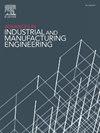Implementation and evaluation of an Augmented Reality framework for sustainable practices in Industry 5.0
IF 3.9
Q2 ENGINEERING, INDUSTRIAL
Advances in Industrial and Manufacturing Engineering
Pub Date : 2025-06-07
DOI:10.1016/j.aime.2025.100166
引用次数: 0
Abstract
Industry 5.0 requires practical methods to translate Augmented Reality (AR) concepts into effective shop floor applications, demonstrating their value to operators. This study introduces a framework for implementing and validating Augmented Reality (AR)-based tools designed to enhance sustainability awareness and assist operators in energy management within industrial settings. The approach combines a reference software architecture for rapid AR deployment with a three-part user-experience assessment, measuring usability (System Usability Scale - SUS), technology acceptance (Technology Acceptance Model - TAM), and cognitive workload (NASA-TLX). To test this framework, an AR-based prototype tool was deployed on enterprise smartphones and evaluated in three scenarios: monitoring service-utility energy consumption, monitoring production equipment, and conducting on- and off-the-job training of the operators. Thirty shop floor professionals completed tasks and provided UX feedback. The results showed good usability (mean SUS 78.4/100), with perceived ease of use and contextual relevance driving technology acceptance. Moreover Nasa TLX analysis indicates mental demand as the predominant factor. The findings confirm that the framework enables effective, human-centered AR deployments in modern industry and provides concrete design guidelines for future implementations.
工业5.0中可持续实践的增强现实框架的实施和评估
工业5.0需要实用的方法将增强现实(AR)概念转化为有效的车间应用,向操作员展示其价值。本研究介绍了一个框架,用于实施和验证基于增强现实(AR)的工具,旨在提高可持续性意识,并帮助运营商在工业环境中进行能源管理。该方法将用于快速AR部署的参考软件架构与三部分用户体验评估相结合,测量可用性(系统可用性量表- SUS)、技术接受度(技术接受模型- TAM)和认知工作量(NASA-TLX)。为了测试该框架,在企业智能手机上部署了基于ar的原型工具,并在三种场景下进行了评估:监测服务公用事业能耗,监测生产设备,以及对操作员进行在职和脱产培训。30名车间专业人员完成任务并提供用户体验反馈。结果显示了良好的可用性(平均SUS 78.4/100),易用性和上下文相关性驱动技术接受度。此外,Nasa TLX分析表明,心理需求是主要因素。研究结果证实,该框架能够在现代工业中实现有效的、以人为本的AR部署,并为未来的实施提供具体的设计指南。
本文章由计算机程序翻译,如有差异,请以英文原文为准。
求助全文
约1分钟内获得全文
求助全文
来源期刊

Advances in Industrial and Manufacturing Engineering
Engineering-Engineering (miscellaneous)
CiteScore
6.60
自引率
0.00%
发文量
31
审稿时长
18 days
 求助内容:
求助内容: 应助结果提醒方式:
应助结果提醒方式:


